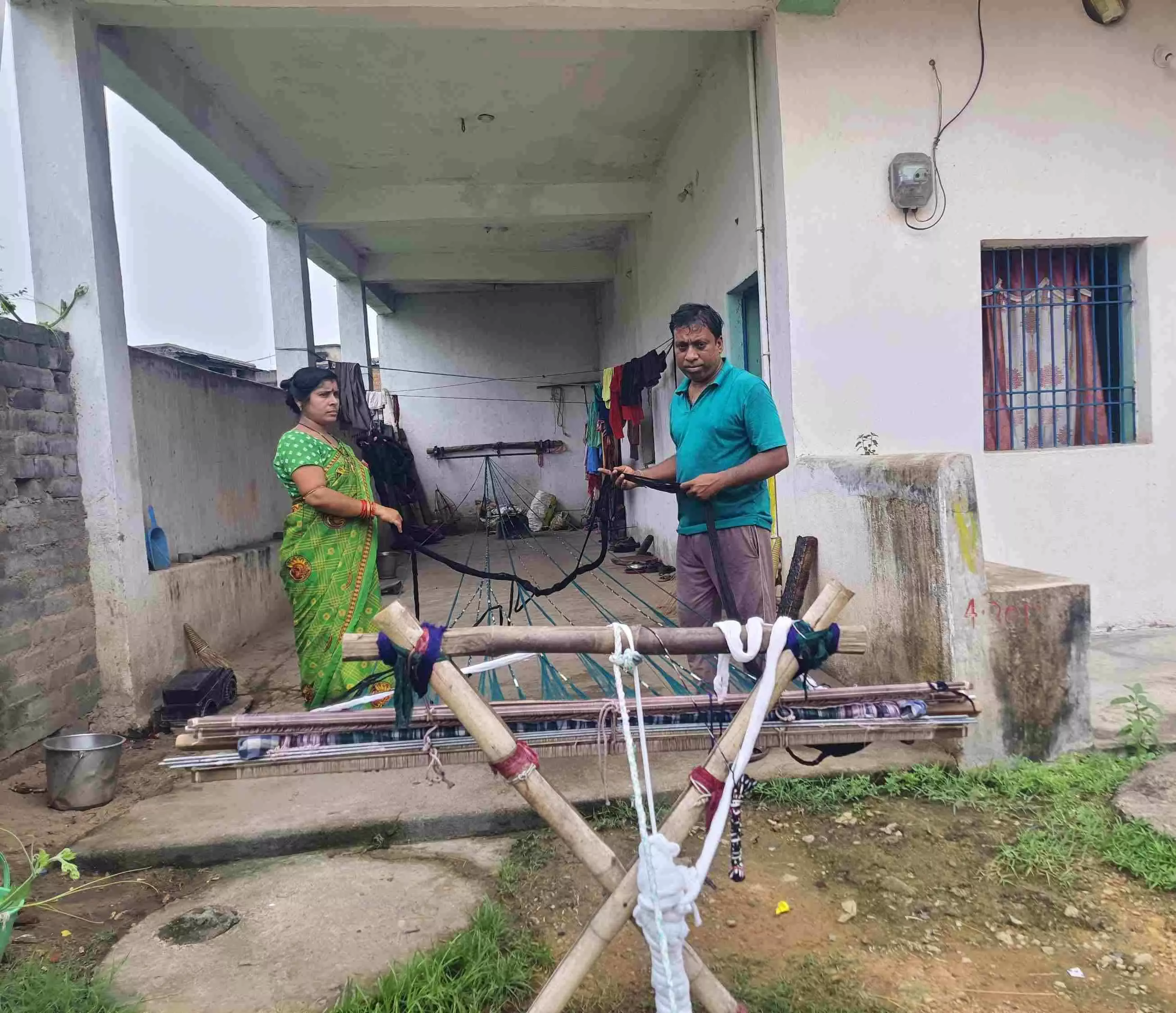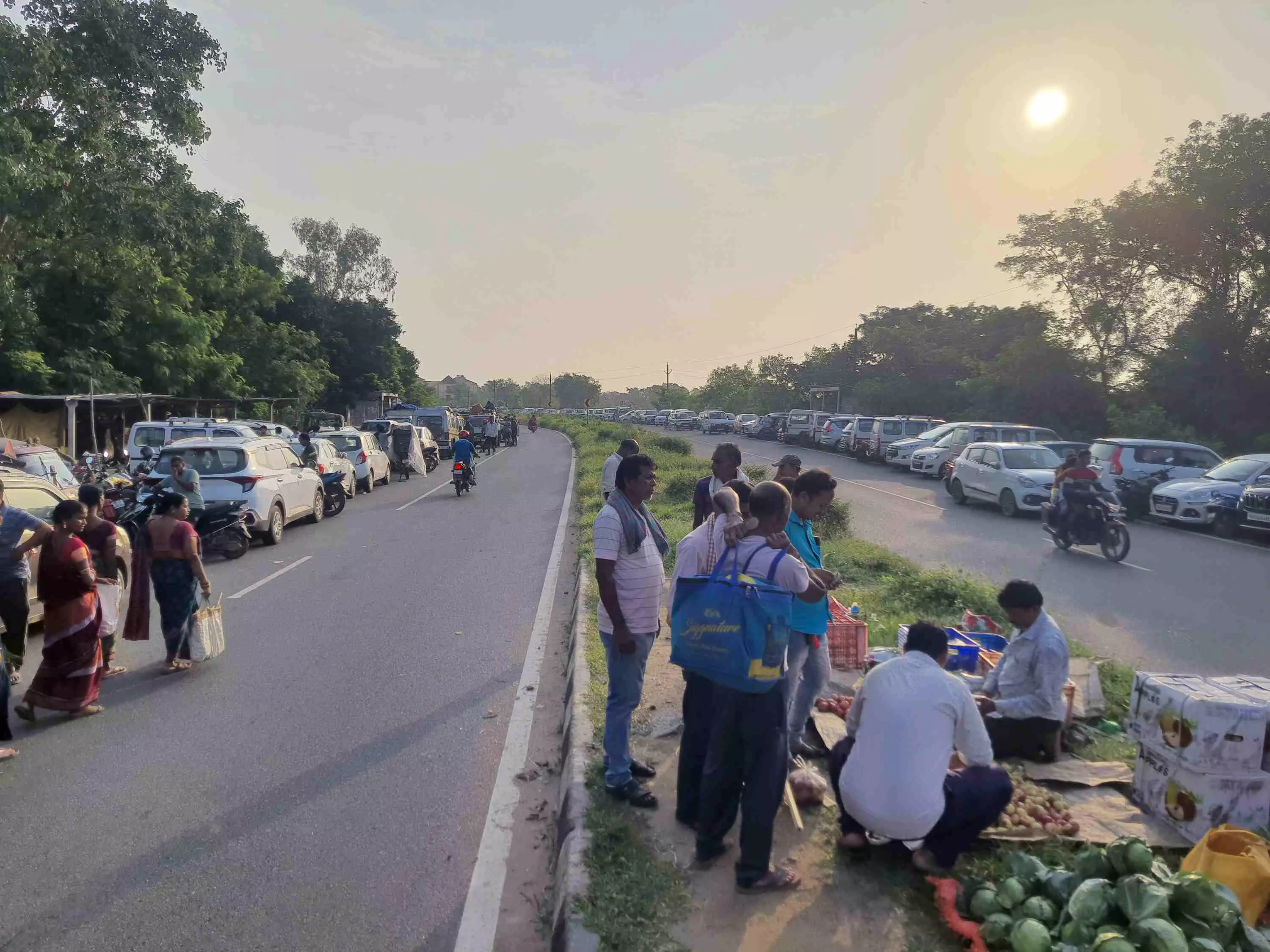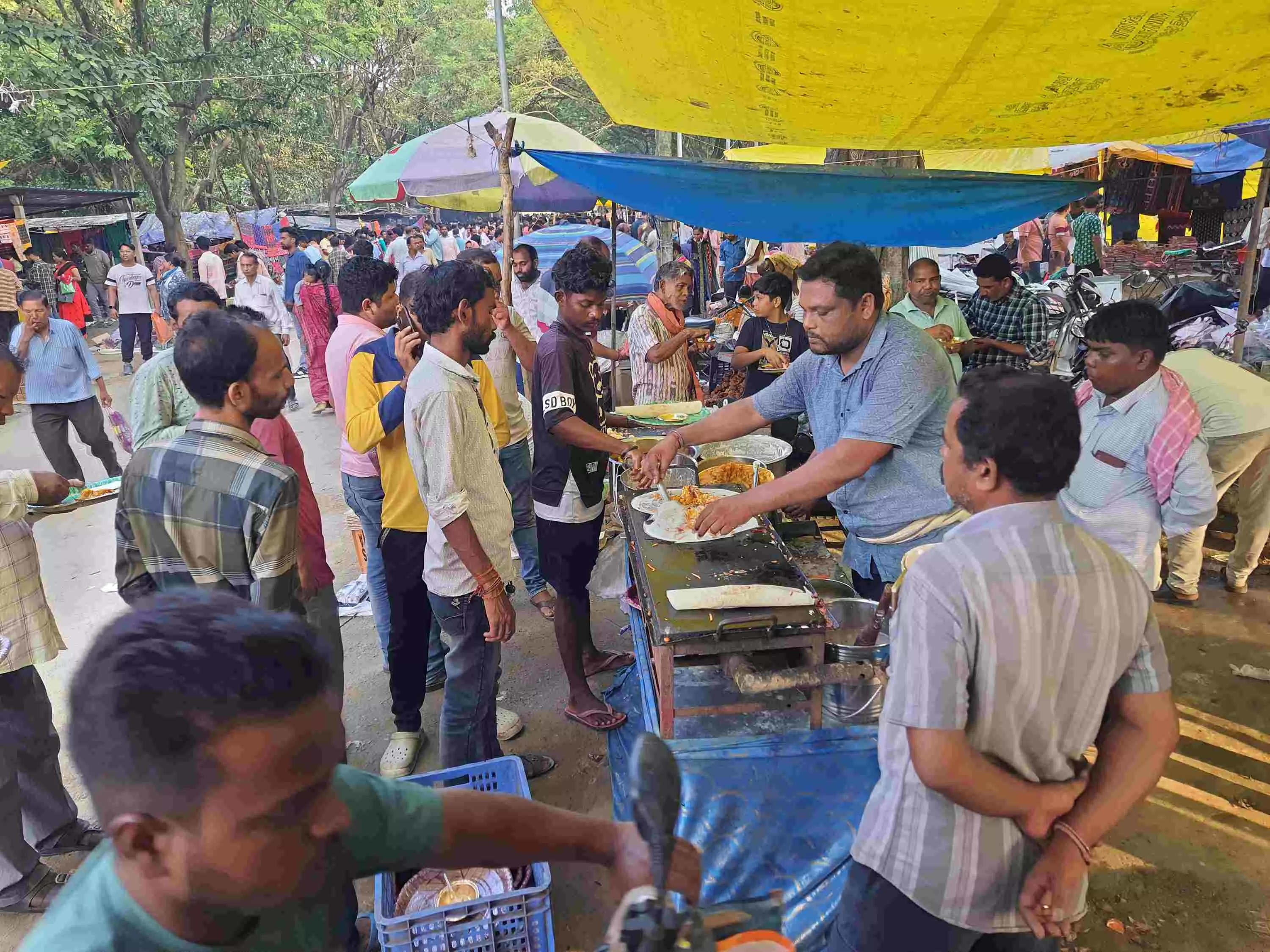Dawn was still two-three hours away. An hour-long shower the previous evening had brought much-needed relief from the sweltering August heat, but the sky remained overcast. Most of Bargarh, a municipal town and district headquarter, was in deep slumber.
The town’s main road, however, was packed with vehicles — cars, bikes, autorickshaws — all hurrying on, as if in a rush to reach somewhere; the noise and chaos of traffic a stark contrast to the quiet that enveloped the rest of the sleeping Bargarh. At the corner of the road, Markanda Bag, 50, was impatiently waiting for an autorickshaw. “Every three-wheeler I have tried to stop has been packed,” he complained.
Minutes later, Markanda finally got lucky. Clutching a bag containing two sarees, the weaver boarded an autorickshaw. “Bhai, tike jaldi chala [brother, please drive a bit faster],” he requested the driver, speaking in Odia.
Their destination, the Balijuri weekly handloom haat, was 12 km away.
Twenty minutes later, the auto carrying Markanda and three others came to a screeching halt near a gate, which identified the place as Behera Bazaar. Outside, hundreds of cars were already parked for over a kilometre on either side of the highway along which it is located.
Wedged in between the towns of Bargarh and Barpali, Balijuri, in Bargarh district, is a nondescript village. Its only distinguishing feature, one that has given it its identity over the decades, is a weekly handloom haat. Though the exact year of the market's origin is not documented, old timers claim the market is a hundred years old. Initially operated from a stretch between Kamal and Uma talkies in Bargarh, the market had shifted to a location on Sub Jail road, near Haatpada locality, for a time, before incidents of theft and snatching prompted another move, this time to its current location. That was over two decades back, remember weavers.
Though technically located in Behera village, the market is popularly referred to as the Balijuri Haat, Balijuri being the neighbouring village to Behera. Dealing exclusively in Odisha’s famed Sambalpuri sarees, Balijuri Haat is said to be the biggest market of its kind in Odisha. Some sources also claim it to be Asia’s largest open-air handloom market.
Operating between 3 am and 8 am every Wednesday, the haat provides weavers a platform to engage directly with customers — both retailers and individual buyers — without losing profit to middlemen. For buyers, the benefit is the much-below-showroom prices at which the sarees are sold here. “A saree that you buy here for Rs 5,000 would be sold for Rs 8,000 in showrooms, that too, after offering a 20 per cent discount,” said Ajodhya Meher, president, Sambalpuri Kapda Bazaar Bunakar Sangha, a weavers association, with a laugh.
For over two decades, 42-year-old Pratap Meher has been a regular at the Balijuri handloom haat. Every week, on market day, he leaves his village, Sarsual in Dunguripali block of Sonepur district, at 1.30am. It takes him approximately an hour to cover the 40 km distance to the market. Once the haat closes, he begins the return journey, typically with Rs 15,000-18,000 in his pocket. When The Federal caught up with him, he had come armed with 10-12 sarees, woven by his eight-member family. In comparison, Markanda and his wife Mohini manage to weave about two sarees a week for the market, said the weaver.
“We enjoy every moment in the haat. I can’t describe the feeling, it can only be experienced,” shared a beaming Pratap, in between displaying a saree to a prospective customer. The customer directed Pratap to keep the saree aside, to be picked up on his way out, as he continued to check out other offerings at the haat.
Despite the late-night travel and early business hours, the weavers showed no trace of exhaustion. Indeed, there was a sense of exhilaration in the air, a sense of happy preoccupation as they catered to their customers.

A couple weaving a saree. Photo by Debi Mohanty
The market’s average weekly turnover is estimated to be Rs 3 crore, said Ajodhya. Festival seasons and winter months brought in more business. A majority of the roughly 3,000 weavers who frequent the haat comprise master weavers — those who employ others from the community to work for them. The weavers receive supplies from the master weaver, and wages once the finished products are collected. The total number of weavers depending on the business from the market would number two lakh, added the bunakar sangha president.
From modest Rs 800 sarees to more dressy drapes priced at Rs 25,000, the market has a wide range of products to choose from. “Sarees priced above Rs 25,000 are limited in number,” added Ajodhya, as he sat, smartphone at ear and a cup of tea held in one hand.
Known for their superior texture, intricate designs, spectacular colours and rich look, Sambalpuri sarees, made from cotton, silk or tussar silk, and woven on a handloom, are regarded as a collector’s item by many saree lovers. In the ’80s former PM Indira Gandhi had become something of a ‘brand ambassador’ for Sambalpuri sarees, recall weavers, she was spotted wearing them so often. Many weavers also count NRIs, living in the US, UK, Canada and Australia, among others, among their clients. Sambalpuri Bandha, a tie-and-dye method used to make Sambalpuri sarees, has a Geographical Identification (GI) tag. In recent years, however, design theft has become a major concern, claim weavers; as a precaution, the Balijuri saree market does not allow photography.
According to Ajodhya, an estimated 2,000 traders from across Odisha, Chhattisgarh and Madhya Pradesh throng the weekly market to stock up on sarees. Local store owners can often be seen leaving the market with cars filled with purchases. Business owners from Kolkata and Delhi too visit, though their number is fewer, Ajodhya added. An additional 500 hawkers or street vendors also come to Balijuri Haat, carrying back sarees on their bikes or cycles, to sell. Then there are the individual shoppers, looking for an exclusive buy for a wedding or festival.
Winter sees better footfalls; “the cold season is conducive for both weaving and marketing,” said Markanda.
A Raipur-based businessman, who has been visiting the market once or twice a month for the past several years, said his father would come here to pick up stock before him. “The market offers a plethora of choices across different price ranges. Sarees are cheaper here,” he said, speaking on condition of anonymity.

Cars parked by the roadside outside the market. Photo by Debi Mohanty
The clock was yet to strike 3.30 am, but at the haat — a roughly seven-acre space lit by hundreds of CFL bulbs — business had picked up. Most of the weavers sat on the ground, their sarees kept in front. Expecting rain, they had not only tied polythene sheets over their heads to protect themselves in case of a downpour, but were ready with plastic bags to cover their precious sarees if need be. “We can afford to get wet, but not the sarees. Even a drop of water renders a saree useless; customers wouldn’t touch it,” said Pratap.
Those with more expensive silk and tussar sarees occupied a concrete platform covered by a tin roof, used to store paddy during procurement season — the weavers share the space with a ‘dhana mandi’ (paddy procurement centre) which operates from the same venue after each harvest season, and two weekly markets selling grocery items and vegetables. While these markets operate later in the day, the weavers concede that during the dhan mandi season, there was an acute shortage of space. “We have tried to learn how to adjust. There is little option left for us,” said Tarini Meher, a 35-year-old weaver
Across the highway stands an imposing, three-storey structure bearing the name Bunakar Bazaar (weavers market). Built by the state handlooms and textiles department at an estimated cost of Rs 5 crore, the complex is said to be equipped with all facilities. The aim, say the weavers, was to shift the handloom haat to this venue and promote it further.
The building lies unused, however; the complex is overgrown with weeds, the shrubbery growing wild. The government had reportedly even served the weavers an ultimatum to shift from the Behera Bazaar to this new structure, but the weavers refused to comply.
The reason, according to Ajodhya, was that the complex has less than 150 rooms. “Where would the rest of the weavers go? The department didn’t consult us before setting up the structure,” he claimed.
The present venue has many infrastructural challenges. Lack of parking space means suitable spots are hard to find and visitors often have to waste time in looking for a space to park their vehicles. There have also been reports of minor accidents while crossing the highway to the market. Though there are public utilities, the numbers are grossly inadequate for a market this size. The result, open spaces being used as public urinals, with the stench of urine always hanging in the air.
According to Ajodhya, the Odisha government has sanctioned Rs 28 crore for the market’s development. “We are hopeful that the government will fulfil our demands and oblige us with a 20-acre patch. That will address our concerns; space for the Haat and parking of vehicles,” he added.
Bargarh member of parliament Pradip Purohit conceded that the market at present lacks infrastructure, but exuded confidence that the state government was determined to develop this iconic market. “I have also raised the issue in Parliament and I met the union textile minister to further discuss the matter,” he added.

Food stalls do brisk business, catering to both buyers and sellers at the market. Photo by Debi Mohanty
Before the Covid pandemic, the market would be held on Fridays. Weavers remember with a shudder the dark months of lockdown when the market could be held, making it difficult for them to eke out a living. “In the first phase of lockdown, we were rendered jobless, looms went silent. We were pushed to the wall,” recalled Tarini. Once the lockdown was lifted, the weavers determinedly made their way back, wearing masks and maintaining social distancing as they sold their ware, said Ajodhya.
The Balijuri market has created a business ecosystem not just for the weavers. Shops selling tea and weaving materials do brisk business, catering to the visitors and weavers. Then there are the cabs and autos ferrying those visiting the market to buy and sell.
Depending on the footfall, the market may run half-an-hour-or-so beyond the closing time of 8 am. By 9am, however, the sarees are sold or packed away for the next week. As the weavers make their way back, many like Pratap, stop for a vada, puri, vegetable chop, samosa or dosa. Some pick up puri with chicken or mutton curry, to be enjoyed with the family back home, as they celebrate the earnings of that week. Soon they would return to the waiting handloom, adding more exquisite weaves to their stocks for the next week’s Balijuri Haat.





